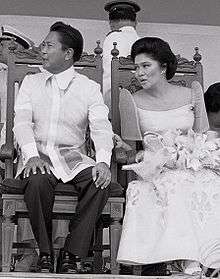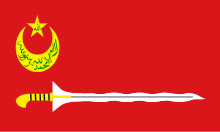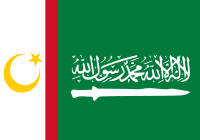Jabidah massacre

The Jabidah massacre was the alleged killing of Moro soldiers by members of the Armed Forces of the Philippines (AFP) on 18 March 1968.[3] It is also known as the Corregidor massacre as the killing took place on Corregidor Island in the Philippines.
The state, at that point in time, had suppressed the affair in the interest of national unity[4] which therefore led to little or no documentation on the incident. This then led to speculations on the number of trainees killed, varying from 11 to 68[5][6] and the reasons behind the massacre.
Some authors[1] believe that the massacre never happened.[7] Rigoberto Tiglao, an activist previously incarcerated during the martial law, said that "the Jabidah massacre was a yarn spun in 1968 by treasonous politicians of the Liberal Party at that time as a propaganda weapon intended to deal what they thought would be a fatal blow to then President Marcos’ bid for reelection the next year."[13]
Background
The north-eastern part of Sabah had been under the rule of the Sulu Sultanate since it was given to them by the Sultanate of Brunei in 1658 for the Sulu Sultanate's help in settling a civil war in Brunei[14] before being "ceded"[15] (in which a translation in Tausug/Philippine Malay translated the word as padjak)[16] to the British in 1878.[15] During the process of decolonisation by the British after World War II from 1946, Sabah was integrated as part of the Malaysian Federation in 1963 under the Malaysia Agreement.[17] The Philippine government however protested this, claiming the eastern part of Sabah had never been sold to foreign interests, and that it had only been "leased" (padjak) by the Sulu Sultanate, and therefore remained the property of the Sultan, and by extension, the property of Republic of the Philippines. Diplomatic efforts to Malaysia and the United Nations during the administration of President Diosdado Macapagal proved futile. On 13 September 1963, the United Nations held a referendum over Sarawak and Sabah, and the people voted to form the Federation of Malaysia.[18]
Operation Merdeka
| Operation Merdeka | |||||||
|---|---|---|---|---|---|---|---|
| Part of North Borneo dispute | |||||||
| |||||||
| Belligerents | |||||||
|
|
• | ||||||
| Commanders and leaders | |||||||
|
|
| ||||||
In 1962, President Diosdado Macapagal renewed the Philippines' 1922 claim over Sabah although the territory has been incorporated into Malaysia.[19][20] Operation Merdeka is a follow-up to this claim. The alleged plan was for trained commandos to infiltrate Sabah and destabilise the state by sabotage which would then legitimise the Philippines' military intervention in the territory and claiming the state which many Filipinos felt was rightfully theirs.[11]
In 1967, President Ferdinand Marcos secretly authorized Major Eduardo "Abdul Latif" Martelino, a Muslim convert, to take charge of the operations of a secret commando unit code-named "Jabidah" and embark on an operation called "Project Merdeka" (merdeka means "freedom" in Malay) to destabilize and take over Sabah.[21] The alleged mastermind, however, included leading generals in the Armed Forces of the Philippines (AFP), Defense Undersecretary Manuel Syquio, and Marcos himself.[5]
The first phase of the operation saw Martelino, with an advanced party of some 17 agents entering Sabah three times to conduct reconnaissance and psychological warfare.[21] It was during the second phase of the operation that the massacre took place. After 180 young Tausugs from Sulu received basic training, they were transported to a remote section of Corregidor Island at the mouth of Manila Bay[11] where they were further trained in guerrilla operations and jungle warfare. Once on the island, the code name was changed to ‘Jabidah’.[5] The real purpose of the formation of Jabidah was never publicised therefore leading to wide speculations and controversies regarding this top secret military plan.[4]
The massacre
There are various accounts about the massacre. One version states that it was caused by a mutiny of the recruits, who were angered by the delay in receiving their allowance.[4][5][11] The poor living conditions and miserable rations for three months led to general discontent among the Muslim trainees who then demanded to be returned home. The recruits were disarmed, some were returned home and some were transferred to a regular military camp in Luzon, but on 18 March one of the two batches of recruits who were supposed to be released were killed by army troops.[5] A lone survivor, Jibin Arula, managed to escape the mayhem with a single gunshot wound to his leg. He gave an account about the atrocity but scholars have opined that the media attention given Arula may have, to some extent, distorted his accounts.[22] The actual events remain unclear as documents were allegedly destroyed by Major Martellino.[5] Arula died in a traffic accident in Trece Martires, Cavite, sometime in August or September 2010.[23]
On the other hand, another school of thought posits that the project, code-named Jabidah involved the recruitment of Muslims trainees who were supposed to be trained to infiltrate and cause chaos in Sabah to strengthen Philippines’ territorial claim.[8] These trainees were informed beforehand that they were joining the AFP to fight "communists", but subsequently learned the true nature of their mission during the latter part of their training.[24] Within this camp, some scholars argue that the massacre was due to the mutiny of the Muslim trainees who denied orders to infiltrate Sabah because they felt that the sabotage against Sabah was unjustified and that they also felt connected with fellow Muslims in Sabah.[25] Other scholars argue that the trainees were killed upon learning the truth of their recruitment to ensure that the information was not leaked.[26] The official narrative denied that the reason for training the recruits were for infiltration in Sabah and that the massacre as stated in the Manila Bulletin, the government-controlled leading print media, occurred because the trainees could not endure hardship during the training.[27] With the lack of substantial evidence, it proved difficult to convict the officers involved in the massacre and thus they were acquitted, which further angered the Muslims.[28][29]
Aftermath
Political play
The opposition senator Benigno Aquino, Jr. exposed that Jabidah was a plan by President Ferdinand Marcos to ensure his continuity of power.[1][30] The incident was used by members of the opposition to criticise Marcos' administration and this was largely covered by the press which caught the government off-guard.[24] The massacre can be seen as a political tool by the opposition to discredit President Ferdinand Marcos for his poor administration and neglect of the Muslims during his term.[31]
International attention
The Jabidah Massacre was so heavily publicised by the media that the government received flak from the international community, especially the Muslim countries.[24] In July 1971, then Prime Minister of Libya, Muammar Gaddhafi, wrote to President Marcos to express his concern. As the Philippines relied on Arab oil, the government tried to defend itself against any accusation and denied any religious repression taking place in Mindanao. The acting foreign Minister added that the problems stemmed from land and political issues which it was ready to solve internally.[29] Then Prime Minister of Malaysia, Tunku Abdul Rahman, also condemned the Philippine government and requested for congressional trial against the officers involved in the massacre.[5] Diplomatic ties between the Philippines and Malaysia were severed[29] as this event also further indicated to Malaysia that the Philippine government still had strong determination to annexe the Malaysian state.[24] In general, this affair had increased the international community’s awareness of the Moro issue in the Philippines.[29]
Protest and formation of the Muslim Independence Movement (MIM)
Many scholars agree that the Jabidah Massacre was one of the most important events in Philippines that ignited the Muslims uprising during Marcos’ regime[32] notwithstanding the truth behind the massacre. Despite undergoing numerous trials and hearings, the officers related to the massacre were never convicted and which was a clear indication to the Muslim community that the Christian government had little regard for them.[9] This created a furore within the Muslim community in the Philippines, especially among the educated youth.[24] The Muslim students saw the need through this incident to unite in protests and organised demonstrations and rallies in Manila with financial backing from Muslim politicians and university intellectuals. One such demonstration was situated near the Malacañang Palace, where the President and his family resided. The students held a week-long protest vigil over an empty coffin marked ‘Jabidah’ in front of the palace.[4]
The massacre significantly brought the Muslim intellectuals, who, prior to the incident had no discernible interest in politics, into the political scene to demand for safeguards against politicians who were using them.[32] Apart from the intellectuals, Muslims in Philippines in general saw that all opportunities for integration and accommodation with the Christians were lost and further marginalised.[5] In May 1968, former Cotabato governor Datu Udtog Matalam announced the formation of the Muslim Independence Movement (MIM) which was regarded by observers as the spontaneous backlash of the Jabidah Massacre.[32] The strong feelings and unity of the Muslim intellectuals were seen as the immediate reaction to the establishment of the MIM[33] which carried far-reaching impacts such as the formation of the Moro National Liberation Front (MNLF) and continued armed struggle in Southern Philippines till today.
Official acknowledgement
President Benigno Aquino III acknowledged the incident on 18 March 2013, when he led commemorations on the 45th anniversary of the massacre. This notably marked the first time that a ruling President had acknowledged the massacre as having taken place. Aquino also directed the National Historical Commission of the Philippines to designate the Mindanao Garden of Peace on Corregidor as a historical landmark.[34]
In popular culture
A 1990 film based on the event starred Anthony Alonzo. It shared the same name however details are fictionalized for the sake of artistic license.[35]
See also
References
- 1 2 3 Senator Benigno S. Aquino Jr. (28 March 1968). "Jabidah! Special Forces of Evil?". Delivered at the Legislative Building, Manila, on 28 March 1968. Government of the Philippines. Archived from the original on 13 September 2015. Retrieved 13 September 2015.
- ↑ Arguillas, Carolyn O. (15 March 2009). "Q and A with Jibin Arula: 41 years after the Jabidah Massacre". Mindanews. Retrieved 29 March 2016.
- ↑ Marites Dañguilan Vitug; Glenda M. Gloria (18 March 2013). "Jabidah and Merdeka: The inside story". Rappler. Archived from the original on 13 September 2015. Retrieved 13 September 2015.
- 1 2 3 4 Cesar Adib Majul (October 1985). The contemporary Muslim movement in the Philippines. Mizan Press. ISBN 978-0-933782-16-7.
- 1 2 3 4 5 6 7 8 Paul J. Smith (26 March 2015). Terrorism and Violence in Southeast Asia: Transnational Challenges to States and Regional Stability: Transnational Challenges to States and Regional Stability. Taylor & Francis. pp. 5–. ISBN 978-1-317-45886-9.
- ↑ Abdurasad Asani (1985). "The Bangsamoro People: A Nation in Travail". Journal Institute of Muslim Minority Affairs. 6 (2): 295. doi:10.1080/13602008508715944.
- ↑ Andrew Tian Huat Tan numbers the victims between 28 and 64, and says that author and social anthropologist Arnold Molina Azurin has written that the massacre is a myth.[8] William Larousse says that a survivor described recruits being shot in groups of twelve. Note 5 on page 130 gives a number of estimates by other sources ranging from 14 to 64.[9] Authors at the Institute of Southeast Asian Studies say that Jibin Arula, described as the sole survivor of the massacre, as numbering his fellow trainees killed at 11, while others numbered them at over 60.[10] Alfred W. McCoy puts Arula in a second group of 12 recruits taken to be killed, and describes his escape.[11] Artemio R Guillermo puts the number of recruits at "about two hundred" and says that only one man escaped being massacred.[12]
- 1 2 Andrew T. H. Tan (1 January 2009). A Handbook of Terrorism and Insurgency in Southeast Asia. Edward Elgar Publishing. pp. 194–. ISBN 978-1-84720-718-0.
- 1 2 William Larousse (2001). A Local Church Living for Dialogue: Muslim-Christian Relations in Mindanao-Sulu, Philippines : 1965–2000. Gregorian Biblical BookShop. ISBN 978-88-7652-879-8.
- ↑ Michael Leifer; Kin Wah Chin; Leo Suryadinata (2005). Michael Leifer: selected works on Southeast Asia. Institute of Southeast Asian Studies. p. 674. ISBN 978-981-230-270-0.
- 1 2 3 4 Alfred W. McCoy (15 October 2009). Policing America’s Empire: The United States, the Philippines, and the Rise of the Surveillance State. Univ of Wisconsin Press. ISBN 978-0-299-23413-3.
- ↑ Artemio R. Guillermo (16 December 2011). Historical Dictionary of the Philippines. Scarecrow Press. p. 293. ISBN 978-0-8108-7511-1.
- ↑ "'Jabidah' was a big hoax". Manila Times.
- ↑ Rozan Yunos (7 March 2013). "Sabah and the Sulu claims". The Brunei Times. Archived from the original on 17 June 2014. Retrieved 20 September 2013.
- 1 2 British Government (1878). "British North Borneo Treaties. (British North Borneo, 1878)" (PDF). Sabah State Government (State Attorney-General's Chambers). Archived from the original (PDF) on 13 September 2015. Retrieved 24 February 2013.
- ↑ Chester Cabalza. "The Sabah Connection: An Imagined Community of Diverse Cultures". Academia.edu. Retrieved 13 September 2015.
- ↑ "United Kingdom of Great Britain and Northern Ireland and Federation of Malaya, North Borneo, Sarawak and Singapore (Agreement relating to Malaysia)" (PDF). United Nations. 1963. Archived from the original (PDF) on 13 September 2015. Retrieved 13 September 2015.
- ↑ "United Nations Malaysia Mission Report, "Final Conclusions of the Secretary-General"". United Nations Malaysia Mission Report. Government of the Philippines. 14 September 1963. Archived from the original on 13 September 2015. Retrieved 13 September 2015.
- ↑ "Appendix V: Aide memoire". Philippine Claim to North Borneo (Sabah), Vol. II. Government of the Philippines. 2 August 1962. Retrieved 26 March 2016.
- ↑ "I. North Borneo Claim (Excerpt from President Diosdado Macapagal's State-of-the-Nation Message to the Congress of the Philippines)". Philippine Claim to North Borneo (Sabah), Vol. II. Government of the Philippines. 28 January 1963. Retrieved 26 March 2016.
- 1 2 "Marcos order: Destabilize, take Sabah". Philippine Daily Inquirer. 2 April 2000. Retrieved 19 June 2015.
- ↑ Rommel A. Curaming; Syed Muhd Khairudin Aljunied; Loh Kah Seng (2013). "Oral History in Southeast Asia: Memories and Fragments (On the Fluidity and Stability of Personal Memory: Jibin Arula and the Jabidah Massacre in the Philippines)". Palgrave Macmillan. New York: Academia.edu. pp. 84–89.
- ↑ Arguillas, Carolyn O. (14 February 2011). "Lone survivor of Jabidah Massacre dies in vehicular accident". Mindanews. Retrieved 29 May 2016.
- 1 2 3 4 5 Macapado Abaton Muslim; Philippines. Office of the President; Mindanao State University. College of Public Affairs (1994). The Moro armed struggle in the Philippines: the nonviolent autonomy alternative. Office of the President and College of Public Affairs, Mindanao State University. ISBN 978-971-11-1130-4.
- ↑ Lela Garner Noble (1976). "The Moro National Liberation Front in the Philippines". Pacific Affairs: 405–424.
- ↑ Max L. Gross; Center for Strategic Intelligence Research (U.S.) (2007). A Muslim archipelago: Islam and politics in Southeast Asia. Center for Strategic Intelligence Research, National Defense Intelligence College. ISBN 978-1-932946-19-2.
- ↑ Syed Serajul Islam (1998). "The Islamic Independence Movements in Patani of Thailand and Mindanao of the Philippines". Asian Survey. University of California Press, JSTOR. 38 (5): 441. doi:10.2307/2645502. JSTOR 2645502.
- ↑ David Wurfel (1991). Filipino Politics: Development and Decay. Cornell University Press. pp. 154–. ISBN 0-8014-9926-7.
- 1 2 3 4 Moshe Yegar (2002). Between Integration and Secession: The Muslim Communities of the Southern Philippines, Southern Thailand, and Western Burma/Myanmar. Lexington Books. ISBN 978-0-7391-0356-2.
- ↑ Nasser A. Marohomsalic (2001). Aristocrats of the Malay Race: A Historic of the Bangsa Moro in the Philippines. N.A. Marohomsalic.
- ↑ Rizal G. Buendia (2002). Ethnicity and Sub-nationalist Independence Movements in the Philippines and Indonesia: Implications for Regional Security. Yuchengco Center, De La Salle University. ISBN 978-971-555-437-4.
- 1 2 3 T. J. S. George (1980). Revolt in Mindanao: The Rise of Islam in Philippine Politics. Oxford University Press. ISBN 978-0-19-580429-4.
- ↑ Mohammed Ayoob (March 1981). The Politics of Islamic reassertion. Croom Helm. ISBN 978-0-7099-0339-0.
- ↑ "Noynoy insists Jabidah massacre true, wants it in history books". The Daily Tribune. House of Representatives of the Philippines. 19 March 2013. Retrieved 13 September 2015.
- ↑ Jerry O. Tirazona. "Jabidah Massacre (1990 film)". Internet Movie Database. Retrieved 13 September 2015.


